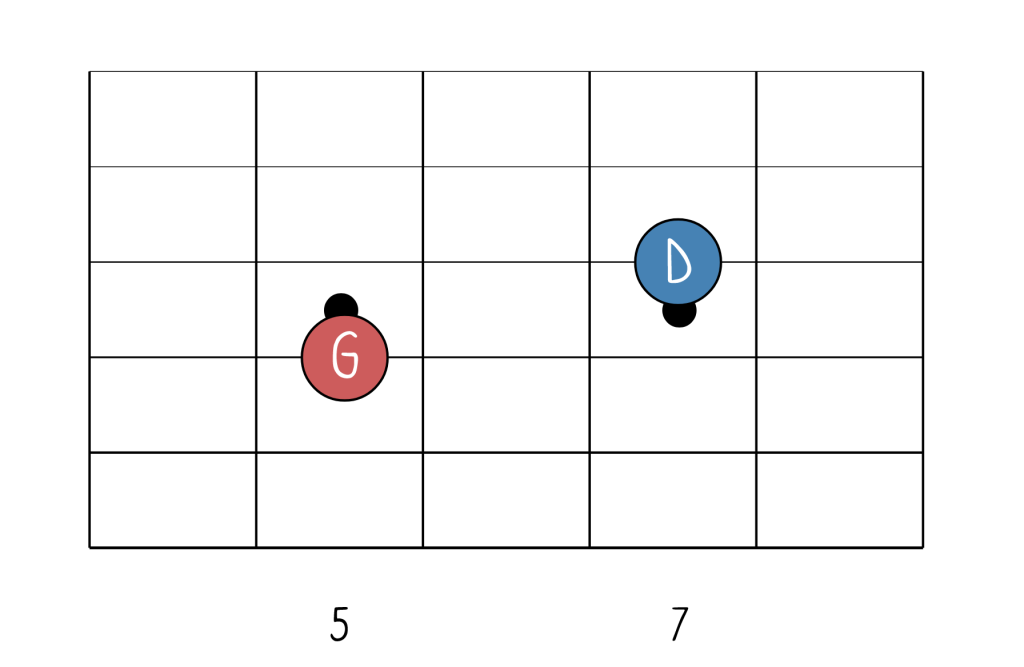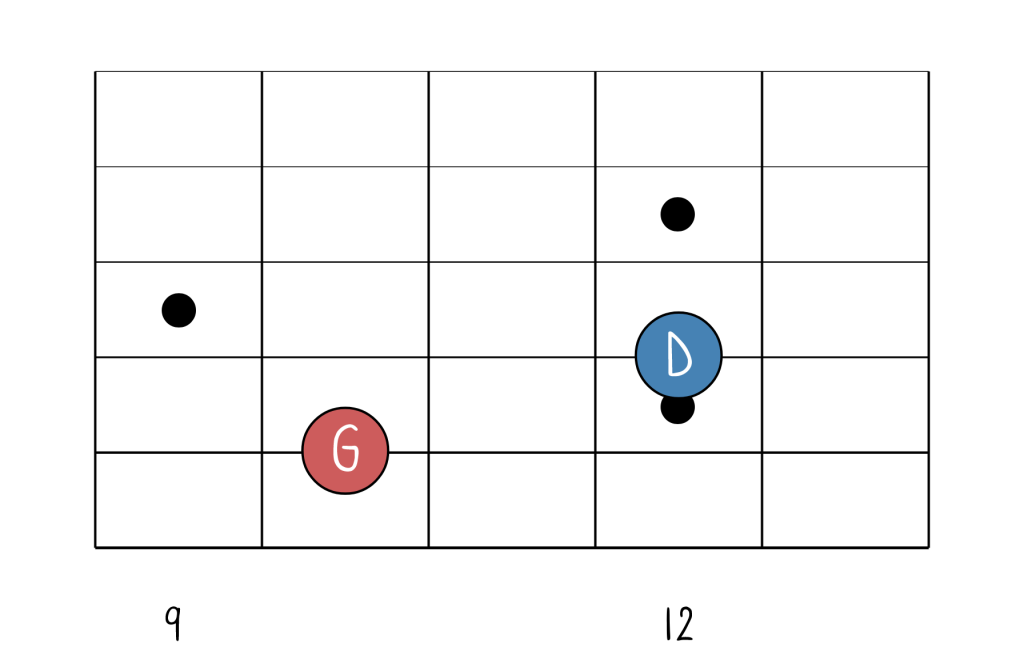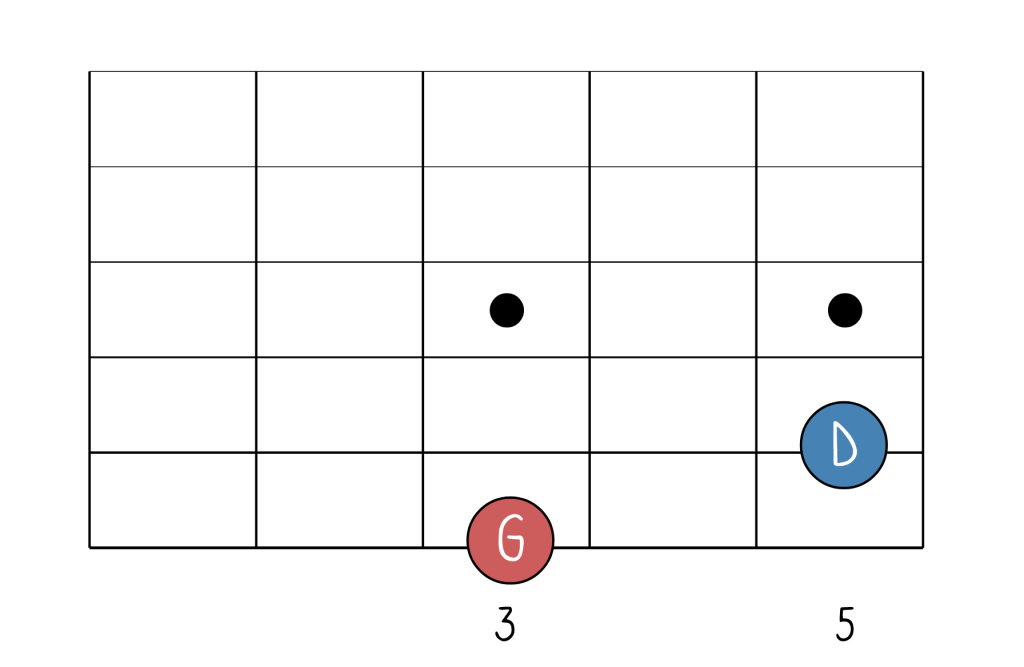22 Play Chord Progressions
Chords in a musical key follow the order of its scale. The first note of a scale can be called the “key note” because that note becomes the key’s name. For example, the C Major scale (first note is “C”) makes up the notes in the key of C Major. When you play a scale in order from the first note to last, you can number each note 1 through 7 before the note repeats again. From each note you can build a chord. In this chapter, we’ll use power chords and barre chords. And so the “One” chord in a key, is the chord built from the first note of a scale. The “Four” chord is the chord built from the 4th note of a scale.
Most often you’ll see roman numerals to indicate the chord. So I will create a table of chords for each key underneath their respective roman numeral which represents their numerical degree in the scale.
The easiest way to get started in applying your fretboard knowledge is with power chords.
Power Chords in all 12 Major Keys – One Shape For All
Key of C Major
| I | II | III | IV | V | VI |
| C5 | D5 | E5 | F5 | G5 | A5 |
Key of G Major
| I | II | III | IV | V | VI |
| G5 | A5 | B5 | C5 | D5 | E5 |
Key of D Major
| I | II | III | IV | V | VI |
| D5 | E5 | F♯5 | G5 | A5 | B5 |
Key of A Major
| I | II | III | IV | V | VI |
| A5 | B5 | C♯5 | D5 | E5 | F♯5 |
Key of E Major
| I | II | III | IV | V | VI |
| E5 | F♯5 | G♯5 | A5 | B5 | C♯5 |
Key of B Major
| I | II | III | IV | V | VI |
| B5 | C♯5 | D♯5 | E5 | F♯5 | G♯5 |
Key of F♯ Major (or G♭ Major)
| I | II | III | IV | V | VI |
| F♯5 | G♯5 | A♯5 | B5 | C♯5 | D♯5 |
Key of D♭ Major (or C♯ Major)
| I | II | III | IV | V | VI |
| D♭5 | E♭5 | F5 | G♭5 | A♭5 | B♭5 |
Key of A♭ Major
| I | II | III | IV | V | VI |
| A♭5 | B♭5 | C5 | D♭5 | E♭5 | F5 |
Key of E♭ Major
| I | II | III | IV | V | VI |
| E♭5 | F5 | G5 | A♭5 | B♭5 | C5 |
Key of B♭ Major
| I | II | III | IV | V | VI |
| B♭5 | C5 | D5 | E♭5 | F5 | G5 |
Key of F Major
| I | II | III | IV | V | VI |
| F5 | G5 | A5 | B♭5 | C5 | D5 |
To understand why the 7th chord is not considered a power chord, get my book “Music Theory and The Fretboard”. Below is the one power chord shape you can use for all power chords. I give you 3 examples for the G5 power chord to show you that it is the same shape.
 |
 |
 |
Barre (Major/Minor) Chords in all 12 Major Keys – 4 shapes
Firstly, there are multiple ways to write the roman numerals for major and minor chords. For example, ii, ii-, II-, and IIm all mean “2 minor” (ie. play the 2nd chord in a major key). I will use 4 different ways to write the roman numerals and cycle through each one so that you can get used to seeing all variations.
Key of C Major (uppercase roman numeral = Major and lowercase roman numeral = Minor)
| I | ii | iii | IV | V | vi |
| C | Dm | Em | F | G | Am |
Key of G Major (roman numerals are all uppercase. Minus symbol means that it’s minor)
| I | II- | III- | IV | V | VI- |
| G | A- | B- | C | D | E- |
Key of D Major (uppercase roman numeral = Major and lowercase roman numeral = Minor. Minus symbol also included.)
| I | ii- | iii- | IV | V | vi- |
| D | E- | F♯- | G | A | B- |
Key of A Major (roman numerals are all uppercase. Little “m” means that it’s minor)
| I | IIm | IIIm | IV | V | VIm |
| A | Bm | C♯m | D | E | F♯m |
Key of E Major
| I | ii | iii | IV | V | vi |
| E | F♯m | G♯m | A | B | C♯m |
Key of B Major
| I | II- | III- | IV | V | VI- |
| B | C♯- | D♯- | E | F♯ | G♯- |
Key of F♯ Major (or G♭ Major)
| I | ii- | iii- | IV | V | vi- |
| F♯ | G♯- | A♯- | B | C♯ | D♯- |
Key of D♭ Major (or C♯ Major)
| I | IIm | IIIm | IV | V | VIm |
| D♭ | E♭m | Fm | G♭ | A♭ | B♭m |
Key of A♭ Major
| I | ii | iii | IV | V | vi |
| A♭ | B♭m | Cm | D♭ | E♭ | Fm |
Key of E♭ Major
| I | II- | III- | IV | V | VI- |
| E♭ | F- | G- | A♭ | B♭ | C- |
Key of B♭ Major
| I | ii- | iii- | IV | V | vi- |
| B♭ | C- | D- | E♭ | F | G- |
Key of F Major
| I | IIm | IIIm | IV | V | VIm |
| F | Gm | Am | B♭ | C | Dm |
55 common 4 chord progressions
| I – VIm – IIm – IV | VIm – I – IIm – IV | VIm – V – I – IIm |
| I – VIm – IV – V | VIm – I – V – IV | VIm – V – IIm – IV |
| I – VIm – IV – IIm | VIm – I – V – IIm | VIm – V – IIm – I |
| I – VIm – V – IIm | VIm – IIm – I – V | VIm – V – IV – I |
| I – VIm – V – IV | VIm – IIm – I – IV | IIm – VIm – I – V |
| I – V – IIm – IV | VIm – IIm – IV – I | IIm – VIm – IV – V |
| I – V – VIm – IIm | VIm – IIm – IV – V | IIm – VIm – V – I |
| I – V – VIm – IV | VIm – IV – I – IIm | IIm – IV – I – V |
| I – IIm – IV – V | VIm – IV – I – V | IIm – IV – V – I |
| I – IIm – VIm – IV | VIm – IV – V – I | IIm – IV – VIm – I |
| I – IIm – VIm – V | VIm – IV – V – IIm | IIm – IV – VIm – V |
| I – IV – VIm – V | VIm – V – I – IV | |
| IV – V – I – IIm | ||
| IV – V – VIm – IIm | I – V – IIm – VIm | V – I – IIm – IV |
| IV – I – V – IIm | I – V – IV – VIm | V – I – VIm – IV |
| IV – I – VIm – IIm | I – IIm – IV – VIm | V – IIm – VIm – IV |
| IV – I – VIm – V | IIm – I – V – VIm | |
| IV – VIm – I – IIm | IIm – IV – I – VIm | |
| IV – VIm – I – V | IIm – IV – V – VIm | |
| IV – VIm – V – IIm | IV – V – I – VIm | |
| IV – IIm – VIm – V | IV – I – V – VIm |
So what do you do?
- Pick a chord progression like “I – VIm – IIm – V” (1 – 6 – 2 – 5)
- Pick a key like the key of C.
- Look at the key of C’s chords and find the named chords based on the numbers given. In this case, I – VIm – IIm – V translates to C – Am – Dm – G.
- Get on youtube and search for “I – VIm – IIm – V backing track in C” or “C – Am – Dm – G backing track”.
- Play along with the backing track.
Major and Minor Barre Chord Shapes
| Major Shape (6th string root) | Minor Shape (6th string root) | Major Shape (5th string root) | Minor Shape (5th string root) |
|
G
|
Gm
|
C
|
Cm
|





Feedback/Errata